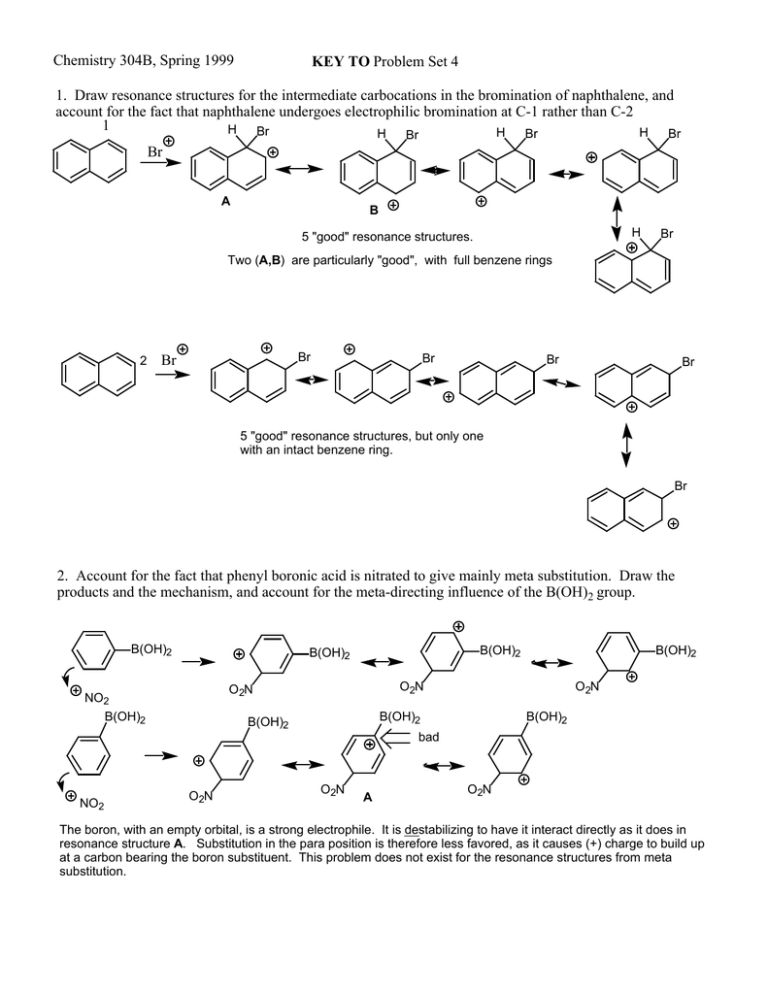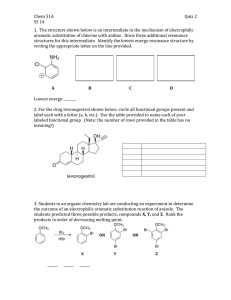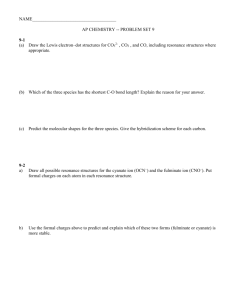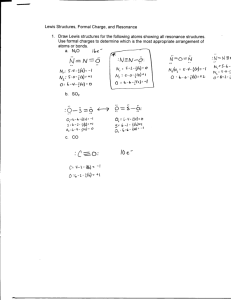Chemistry 304B, Spring 1999 KEY TO
advertisement

Chemistry 304B, Spring 1999 KEY TO Problem Set 4 1. Draw resonance structures for the intermediate carbocations in the bromination of naphthalene, and account for the fact that naphthalene undergoes electrophilic bromination at C-1 rather than C-2 1 H Br H H H Br Br Br Br A B H 5 "good" resonance structures. Br Two (A,B) are particularly "good", with full benzene rings 2 Br Br Br Br Br 5 "good" resonance structures, but only one with an intact benzene ring. Br 2. Account for the fact that phenyl boronic acid is nitrated to give mainly meta substitution. Draw the products and the mechanism, and account for the meta-directing influence of the B(OH)2 group. B(OH)2 B(OH)2 B(OH)2 O2N O2N NO2 B(OH)2 B(OH)2 O2N B(OH)2 B(OH)2 B(OH)2 bad NO2 O2N O2N A O2N The boron, with an empty orbital, is a strong electrophile. It is destabilizing to have it interact directly as it does in resonance structure A. Substitution in the para position is therefore less favored, as it causes (+) charge to build up at a carbon bearing the boron substituent. This problem does not exist for the resonance structures from meta substitution. 3. Rank the compounds in each group in terms of their reactivity toward electrophilic substitution. a. PhCl, o-dichlorobenzene, benzene Cl is a weak de-activating group for electrophilic aromatic substitution; two are worse than one. most reactive: benzene > ClPh >o-dichlorobenzene Due to the inductive effect of Cl b. p-bromonitrobenzene, nitrobenzene, phenol Nitro is a powerful deactivating group; hydroxyl is a powerful activating group; Br is a weak deactivating group. Therefore the order is: phenol > nitrobenzene > bromonitrobenzene c. fluorobenzene, benzaldehyde, o-xylene O This is a little tricky because we do not have comparison data for F vs to analyze the situation. H so I am expecting you F is the most powerful single group for removing electron density, but it can also donate back (resonance effect) from its non-bonding electrons if it is attached to a pi system (as in benzene). Definite deactivation. C=O is a powerful deactivator because of the double bond to an electronegative atom, by both inductive and resonance effect analysis. Probably stronger than F Me (in xylene) is a net stabilizer of (+) charge (hyperconjugation)-- activator o-xylene > fluorobenzene > benzaldehyde 4. Assume you could achieve monomethylation with chloromethane and AlCl3, and predict the major product with the following substrates: a. bromobenzene para-methyl (Br is o/p directing; para is less hindered) b. p-chloroaniline c. 2,4-dichlorophenol ortho-methyl-p-chloroaniline (NH2 dominates, favors ortho d. benzoic acid over meta, and para is blocked) OH is powerfully o/p directing. The Me goes in to the only available o/p position, to give 2,4-dichloro-6-methylphenol meta-methylbenzoic acid. CO 2H is meta directing 5. Would you expect the Friedel-Crafts reaction of benzene with R- 2-chlorobutane to yield predominantly a single stereoisomer or a racemic product? Write the mechanism and the product(s) and explain your analysis. Probably. To the extent that the chlorobutane is induced to ionize under the reaction conditions, there will be racemization through the planar carbocation. This is likely for a secondary carbocation. The alternative is an SN2 like process, with inversion of configuation. Not likely under ionizing conditions and secondary. 6. Cycloheptatrienone is a quite stable, "normal" ketone while cyclopentadienone is exceedlingly reactive, in, for example, a self-Diels-Alder reaction. Draw the Diels-alder product, and rationalize the difference in reactivity. O O O D-A O O O O O O or neither of these dipolar resonance structures is good; One has + on oxygen and the other has a 4 e- cyclic pi system. 7. Draw all the "good" resonance structures for phenanthrene and predict which is the shortest carbon-carbon bond length in the molecule. They all appear to be equal in energy, equal contributors to the overall molecule. The C-C bond indicated with an arrow is a double bond in all but one (inside square) of the structures. All of the other bonds are single bonds in at least two of the structures. Therefore, by this picture, the bond indicated by the arrow should be shorter (more like a double bond) than any of the others.




